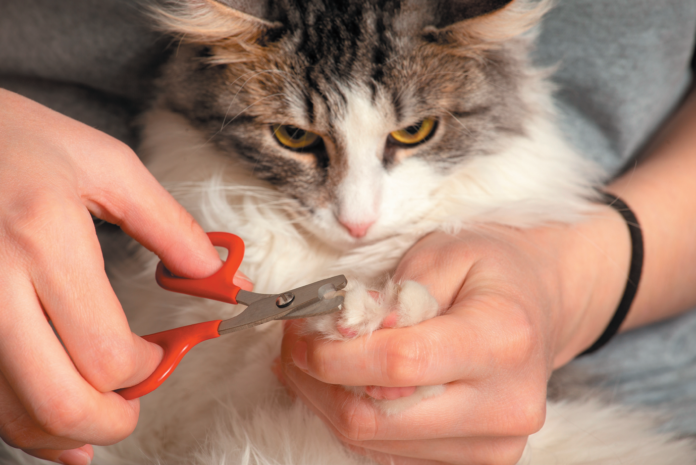Some cats don’t like to be handled, especially around their paws, so their owners avoid regular nail trimming. That can spell trouble not only for upholstered furniture, rugs, and soft wood that can easily be scratched (as can your lap when your pet kneads on you). It’s also potentially bad for the cat. If her nail gets caught in something like plush carpet or even a soft piece of wood, it can result in a broken claw — and a lot of pain. Nails that become extremely overgrown can also curve back into the footpad, creating mobility issues in addition to pain.
That’s why the ASPCA recommends trimming a cat’s nails every 10 days to two weeks. The Humane Society of the United State offers similar advice, suggesting “every few weeks.” Scratching posts help, but are usually not enough on their own to keep the nails sufficiently trimmed.
We can understand not wanting to alienate your cat (or having to fend off an unpleasant reaction) by regularly trimming her nails. But her safety comes first. Besides, you can accustom her to the process. It doesn’t have to be a struggle.
Consider that you need only to snip the sharp tip at the very end of each nail. That’s all it takes to keep you, your cat, and your furniture safe. In fact, if you go any further than the tip, you risk cutting into the quick — a bundle of sensitive nerves and blood vessels that reaches about midway into the nail. The result is pain and, potentially, bleeding.
Keep in mind, too, that you only have to trim the nails on your pet’s front paws — unless she hurts you when she jumps on and off your lap. Then you can repeat the process on the hind claws, as well.
Tools to choose from
A variety of of different kinds of nail clippers will do the trick, from a special pair of scissors that holds a cat’s nail in place to clippers that are a little like pliers. There are even sliding blades that act like a tiny guillotine. And some people (and their cats) do fine with nail clippers meant for people. Use the tool that feels best in your hands.
Just be sure the blade remains sharp. A dull blade can cause unnecessary pain and make a nail split and even bleed. If you need to replace a nail clipper to avoid these mishaps, it’s worth the money. Many feline nail clippers cost less than $10, and very few cost more than $20.
A soft, gentle approach
If you’ve never clipped your cat’s nails before, don’t expect to clip them all on the day you buy a trimmer. Try this progression:
- Choose a time that you cat is feeling relaxed and maybe even a little sleepy so she is more likely to be compliant.
- Put your cat on your lap, in the crook of your arm, or on a chair or counter that you kneel beside — whichever feels comfortable and secure for the two of you. Then touch and gently massage one of your cat’s paws for 2 or 3 seconds, pushing gently on the tops and bottoms to make the claws extend. If she complies, coo over her and give her a delicious treat. If she doesn’t, ease up and try again when she has calmed down a little.
- Get to know all of your cat’s front paws this way over what might easily take a few weeks. There’s no rush. Continue to go one paw at a time, and keep the praise and the treats coming as she eases into the process. Never show frustration or impatience, and let her be the one to end the session — or better yet, end it before she lets you know she’s done.
- When you feel she’s comfortable with the routine, clip one nail. Remember — trim it just at the very pointy tip.
- The next day, or perhaps two days later, try another nail. It’s fine to continue praising her and rewarding her with food morsels if that helps her cooperate. Over time, you may be able to trim all the claws on a foot at once, or you may not. It doesn’t matter, as long as each one gets snipped every two or three weeks.
What’s key is patience. If you’ve never trimmed your cat’s nails before, easing into it over the course of a month or so is fine. The bigger deal is keeping your bond intact as you take care of her health needs.





I have a 13 month old neutered male Siamese. He likes to chew things, especially paper things. He ignored the cardboard box I put down, and went straight for the mail on the kitchen table–not to mention the pre-paid packaging label.
He jumps up on my computer desk very frequently when I am on the computer. He must think I am a toy??? because he bites and grabs me with his paws. I tell him sternly NO–he stops for 2 seconds and is back at it. He has drawn blood only a couple of times-very little–but I get annoyed at being a constant nibble treat.
He also gets up on the table and the counter when I am preparing “stuff”. I put him down=-but he is right back to it. I have some granny’s bitter apple. Once or twice I spray around where i am working–and he will go away for a while. Suggestions please. Got Q from a shelter 10 weeks ago, and do not really know previous history.
Still young? He’ll grow out of it.
When he grabs you with his paws and bites he is communicating. Or trying to — you two are just not speaking the same language. Your “no” probably doesn’t mean anything to him. Try making a sound which imitates a hurt cat. (When he bites.) When you’re working at the computer, have some small toys there on your desk — little balls, little mice. (Hide them in a box or basket.) When he comes up to bother you he wants to play — throw a little toy away from your desk so he’ll go after it.
If he doesn’t have a cat “tree,” get one for him. Cats need vertical space. Jumping up on the table or counter where you are doing something is a natural behavior. He wants to see what you’re doing, what you’ve got there.
It’s not too late — you could adopt another boy close to the same age. If he has a playmate he will bother you less.
Yes, Q is still very young. He wants to play a LOT. Ideally he needs another cat to play with. Kittens are best adopted in pairs.